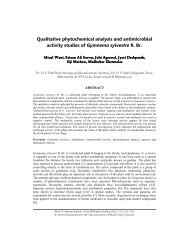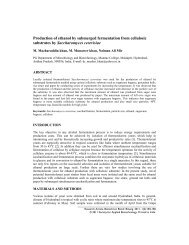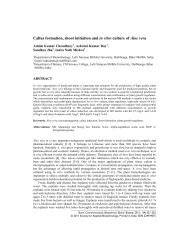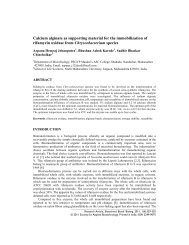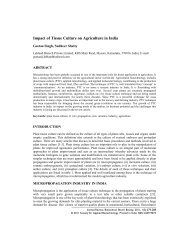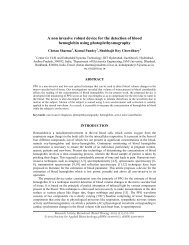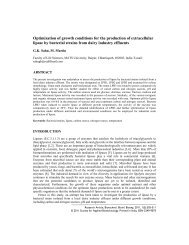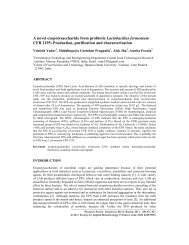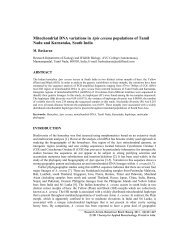Development of microcrystalline cellulose from groundnut shells for ...
Development of microcrystalline cellulose from groundnut shells for ...
Development of microcrystalline cellulose from groundnut shells for ...
You also want an ePaper? Increase the reach of your titles
YUMPU automatically turns print PDFs into web optimized ePapers that Google loves.
375<strong>Development</strong> <strong>of</strong> <strong>microcrystalline</strong> <strong>cellulose</strong> <strong>from</strong> <strong>groundnut</strong><strong>shells</strong> <strong>for</strong> cadmium degradationL.R. Hemanth 1 , Rashmi S. Hulagurmath 2 , R. Suresh 1 ,Roopa L. Farshi 1 , S.H. Kavitha 31 Department <strong>of</strong> Chemical Engineering, R.V. College <strong>of</strong> Engineering, Bangalore, Karnataka,560059, India; E-mail: hemanthlr@rvce.edu.in2 Department <strong>of</strong> Chemical Engineering, S.D.M. College <strong>of</strong> Engineering and Technology, Dharwad,580002, Karnataka.3 Department <strong>of</strong> Biotechnology, PES Institute <strong>of</strong> Technology, Bangalore, Karnataka, 560085, India.ABSTRACTWater is the vital element <strong>for</strong> the living organisms and also <strong>for</strong> the ecological balance <strong>of</strong> the environment. Thewater resources are being polluted continuously by the various activities <strong>of</strong> the man. The industrial activitiesare the direct methods <strong>for</strong> water pollution. The industrial activities release metals, non-metals, unreactedcompounds and byproducts to the water resources. The polluting compounds mainly include dyes, chlorinecompounds, cadmium, fluorides, ketones and other compounds. The works are being carried out <strong>for</strong>degradation <strong>of</strong> pollutants and to develop suitable methods <strong>for</strong> the removal <strong>of</strong> these polluting compounds. Thepresent experiment involves the preparation <strong>of</strong> <strong>cellulose</strong> powder <strong>from</strong> agricultural products and its application<strong>for</strong> removal <strong>of</strong> cadmium material. The paper describes the development <strong>of</strong> <strong>microcrystalline</strong> <strong>cellulose</strong> <strong>from</strong><strong>groundnut</strong> <strong>shells</strong> by the digestion process. The raw material is digested in a steam jacket reactor followed bytreatment with an alkali, bleaching and drying. The dried powder is characterized <strong>for</strong> its properties and theparticle size is estimated. The final dried powder is used <strong>for</strong> batch adsorption studies <strong>for</strong> degradation <strong>of</strong>cadmium compounds and <strong>for</strong> the kinetic studies. From adsorption studies the parameters such as effect <strong>of</strong> pH,concentration, adsorption isotherms and kinetics <strong>of</strong> adsorption process are estimated.Keywords: cadmium, <strong>groundnut</strong> <strong>shells</strong>, mineral acids, digester, <strong>cellulose</strong>, adsorption isotherms, Dubinin-Radushkveich isothermINTRODUCTIONThe availability <strong>of</strong> clean water has become a prime issue in all countries due to the depletion <strong>of</strong>water resources by industries, over population and due to non-compliance <strong>of</strong> environmentalregulations. The wastewater can be treated by variety <strong>of</strong> techniques such as electrodialysis,distillation, use <strong>of</strong> water sediment filters and chemical agents, reverse osmosis, activated carbon andion exchange [1,2]. The adsorption technique is a frequently applied method in the industries.Industrial waste streams <strong>of</strong> metal cleaning, plating baths, mining, printed circuits, metallurgical,pulp and paper, fertilizers, petroleum refining, wood preserving and excessive use <strong>of</strong> agro-chemicalscause the contamination <strong>of</strong> water and soil. The adsorbents are either chemical compounds orcompounds developed <strong>from</strong> biological material. Some <strong>of</strong> the biological materials employed asadsorbents are sawdust, maize corns, rice husks and sugarcane [3,4].Cadmium is one <strong>of</strong> the water-polluting compounds that are let <strong>of</strong>f <strong>from</strong> the various industrialactivities. Cadmium is used commonly in battery industries, coating and plating industries and inplastic industries. Naturally a very large amount <strong>of</strong> cadmium is released into the environment, about25,000 tons a year. About half <strong>of</strong> this cadmium is released into rivers through weathering <strong>of</strong> rocksResearch Article, Biotechnol. Bioinf. Bioeng. 2011, 1(3):375-380© 2011 Society <strong>for</strong> Applied Biotechnology. Printed in India; ISSN 2249-9075
378isotherm equation is derived <strong>for</strong> adsorption on microporous and mesoporous solids <strong>from</strong> statisticalmechanical principles [13]. The adsorbed phase is assumed to be a two-dimensional fluid subjectedto a <strong>for</strong>ce field represented by a mean potential (Phi). For adsorption in micropores and mesopores,the fractional adsorption (theta) is much greater than the relative pressure. From the approximated<strong>for</strong>ms <strong>of</strong> the general isotherm, it is shown that the exponent n in the equation is related to the degree<strong>of</strong> pore filling at the reference state; as a consequence it depends on the adsorbate as well as the porestructure <strong>of</strong> the adsorbent. Thus, the dependence <strong>of</strong>f on pore size can be obtained directly <strong>from</strong> firstprinciples without resorting to empirical correlations.ln q=ln q e -βε 2 --------------------------------------------Equation 2andε=RT ln(1+1/c) --------------------------------------------Equation 3where, C e is the liquid phase concentration <strong>of</strong> cadmium ions at equilibrium, mg/l, C is the liquidphase concentration <strong>of</strong> cadmium ions (mg/l), q is the amount <strong>of</strong> cadmium ions adsorbed (mg/g), q eis the amount <strong>of</strong> cadmium ions adsorbed at equilibrium (mg/g), ε is potential and β is D-Rparameter with q, T.RESULTS AND DISCUSSIONThe <strong>groundnut</strong> shell that contains more than 93% <strong>of</strong> alpha <strong>cellulose</strong> was used as a primary rawmaterial <strong>for</strong> the development <strong>of</strong> <strong>microcrystalline</strong> <strong>cellulose</strong>. The <strong>groundnut</strong> husk is used as cattlefeed, carrier <strong>of</strong> insecticide and <strong>for</strong> manufacture <strong>of</strong> briquettes. In the process the secondary standardsolution hydrochloric acid (1N) was standardized by nitric acid (1N), which was again standardizedby sodium hydroxide solution (1N) with potassium hydrogen phthalate (1N) and phenolphthaleinindicator. The dried <strong>microcrystalline</strong> powder was subjected to various tests to confirm its propertieswith standard <strong>microcrystalline</strong> powder [14]. The powder was dispersed in iodinated zinc chloridesolution; the appearance <strong>of</strong> violet blue indicates the identification test. The solubility test wascarried out by dissolving in copper tetramine solution; the developed compound completelydissolves without residue confirming the solubility <strong>of</strong> compound. The loss on drying at 105°C was1.2% <strong>for</strong> 3 hours <strong>for</strong> the developed material whereas the value is greater than 6% <strong>for</strong> other<strong>microcrystalline</strong> materials. The particle size <strong>of</strong> the material was 75.87 mm, which was determinedby ICI sedimentation technique.The developed <strong>microcrystalline</strong> <strong>cellulose</strong> was applied <strong>for</strong> the cadmium removal in a batchoperation. The analysis was carried out by atomic absorption spectrophotometer. The cadmiumabsorption increased as shown in figure 1 <strong>for</strong> the duration <strong>of</strong> 60 minutes. The stock solutioncontaining 663 ppm <strong>of</strong> cadmium was reduced to 83.36 ppm over the 60 minutes operation. After theabove time there was no change in concentration and material was reused again <strong>for</strong> the same initialconcentrations and constant result was obtained. The isotherms were developed by the aboveconcentration values and are represented in figure 2 and 3. The regression value <strong>of</strong> the Dubininisotherm is higher and nearer to 1 compared to Langmuir isotherm. Hence, the material obeys theDubinin isotherm, which is applicable <strong>for</strong> porous material. The material was repeated with somemore trials and the regression values were found to be higher than other isotherm. The resultsindicate that the material can be successfully employed <strong>for</strong> cadmium degradation in batch operation.The material can be even tested <strong>for</strong> degradation <strong>of</strong> other polluting compounds, heavy metals andother dyes.
379% Absorbance vs Time% absorbance8060402000 20 40 60 80time(min)Figure 1. The concentration behavior <strong>of</strong> the cadmium removal in a batch adsorption process.Langmuir plot1/qe0.30.250.20.150.1R 2 = 0.81330.0500 1 2 3 41/CeFigure 2. Langmuir plot <strong>for</strong> cadmium degradation.ε 2Dubinin plotln qe108R 2 = 0.94464200 5000000 10000000 15000000ε*εFigure 3. Dubinin plot <strong>for</strong> cadmium degradation in a batch adsorption process.
380REFERENCES[1] Hu CY, Lo SU, Kuan WH. Water Res. 2003, 37:4513-4523.[2] Hu CY, La SL, Kuan WH. Journal <strong>of</strong> Hazardous Materials 2007, 145:180-187.[3] Brown PA, Allen SJ. Water Res. 2000, 34:3907-3916.[4] Corapcioglu MO, Huang CP. Water Res. 1987, 21:1031-1044.[5] Julita MP, Andrew H, Hanna PK. Environment International 2005, 31:513-521.[6] Yavaz O, Guezel R, Aydin F, et al. Polish Journal <strong>of</strong> Environmental Studies 2007, 16, 467-471.[7] Vazquez G, Alvarezo G, Freire MS, et al. Global NEST Journal 2009, 11:196-204.[8] de Hoces MC, de Castro FHB, Garcia GB, Rivas GT. Environmental Progress 2006, 25:261-266.[9] Gosset T, Trancart JL, Thevenot DR. Water Res. 1986, 20:21-26.[10] Osman HE, Badwy RK, Ahmad HF. Journal <strong>of</strong> Phytology 2010, 2:51-62.[11] Heydarzadeh HP, Najaxpour GD, Moghaddam AAN. World Applied Science Journal 2009, 6:564-569.[12] Rahul G, Marathe KV. Indian Journal <strong>of</strong> Chemical Technology 2007, 14:362-370.[13] OkoroIA, Abii T. American Journal <strong>of</strong> Scientific and Industrial Research 2011, 2:386-390.[14] Mendham J, Denney RC, Barnes JD, et al. Vogel’s Quantitative Chemical Analysis, 6 th ed., Prentice Hall,New York, 2000.



